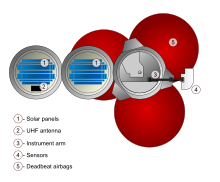Beagle 3

Beagle 2: Evolution (also called Beagle 3) is a cancelled Mars lander mission which intended to search for life on Mars, past or present. Beagle 3 was the proposed successor to the unsuccessful British Beagle 2 Mars lander (which disappeared during its landing in 2003). The craft was also being designed by Professor Colin Pillinger, lead scientist on the previous venture. EADS Astrium also played a part in funding and early development of the project. Pillinger hoped to launch up to two landing craft from an orbiter in 2009 as part of the European Space Agency's Aurora Programme.
After the Beagle 3 project was cancelled in 2004, professor Pillinger proposed to the American space agency (NASA) to include a scientific module originally meant for the Beagle 3 in the Mars Science Laboratory Mars lander,[1][2] but the proposal was not accepted. The Beagle craft were named after the ship HMS Beagle that took Charles Darwin around the world.
Proposed technology
- Advanced solar cell technology, meaning two cells as opposed to the previous four
- Fanfold system - so the top of the vehicle remains horizontal (location for the main UHF antenna)
- Powerful X-band (8.0 to 12.0 GHz) antenna for direct vehicle-to-Earth radio link on the vehicle's main shell, to provide real-time descent statistics
- New lithium-ion battery technology - to be able to operate at lower temperatures, meaning less power wasted on heating - a possible 60% capacity boost to that of Beagle 2
- Deadbeat airbags, which inflate just before touch-down, and gently deflate during landing, so that the probe could come to a stop where it lands, and not bounce to a stop.
- Life-chips, which detect the presence of amino acids.
See also
References
- ^ Rincon, Paul (26 July 2004). "'Beagle 3' looks to American ride". BBC News. Retrieved 2008-11-16.
{{cite news}}: Cite has empty unknown parameter:|coauthors=(help) - ^ Highfield, Roger (25 Aug 2004). "Beagle 'may go to Mars on Nasa's flying bedstead'". The Telegraph. Retrieved 2008-11-16.
{{cite news}}: Cite has empty unknown parameter:|coauthors=(help)



